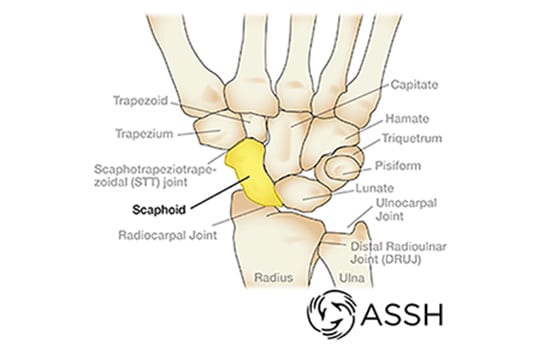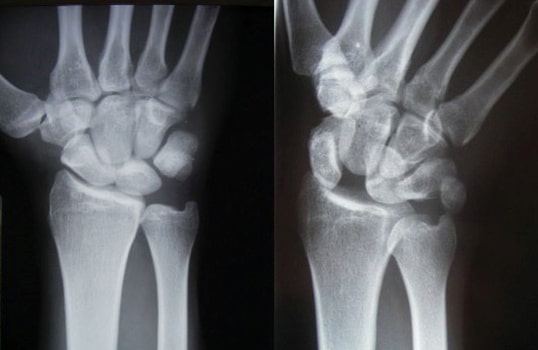Description
A ligament is a thick band of tissue that connects two bones. There are many ligaments in the wrist. When a ligament is injured, this is referred to as a sprain. A very common ligament injured in a sprained wrist is the scapholunate ligament. This ligament is in the middle of the wrist between the scaphoid and lunate bones (Figure 1). It is an important structure for painless and full wrist motion. There are different degrees of injury to the scapholunate ligament, varying from stretching to a torn ligament. Any injury can cause the wrist to be unstable and painful.
Figure: The scapholunate ligament is between the scaphoid and lunate bones.
Figure: X-ray showing a gap between the scaphoid and the lunate (left) and a normal x-ray (right), indicating a torn ligament.
CausehELLO
The scapholunate ligament usually tears when there is a lot of stress put on the wrist. A common cause is a fall onto the hand. Typically, the ligament is injured when the wrist is bent backward or into an unusual position. Sometimes, the ligament stretches out over time. This can be due to repeated strains or loosening with age. Long-standing inflammation can also cause the gradual breakdown of the ligament. This ligament is often injured by chronic gout.
Signs and Symptoms
- Pain when bending the wrist backward
- Limited range of motion
- Bruising
- Pain and swelling that has developed over several days, usually on the back side of the wrist
- Popping or grinding
- Weakness in the wrist
The pain and swelling you feel with a scapholunate ligament injury may happen right after an injury. It may persist and can worsen over time. Some people, though, will only notice a problem many years after the initial injury.
Doctor Examination
The diagnosis of a scapholunate ligament injury may be difficult to make. Your doctor will examine your wrist to see where it hurts and to check how it moves. Your surgeon may compare the injured wrist with the uninjured wrist.
X-rays are often used to help understand your wrist pain. Although ligaments are not visible on an X-ray, it will show the bones of your wrist. The spacing and alignment of the bones in the wrist changes when the scapholunate ligament is injured or you have a torn ligament. This ligament usually holds the scaphoid and the lunate together. When it is injured, the scaphoid and lunate move apart and a gap is visible (Figure 2). An MRI is sometimes needed to confirm the diagnosis. MRI allows your surgeon to see the degree of ligament injury. Sometimes having a radiologist inject dye into the joint before the MRI helps to find a torn ligament. This is called a MR arthrogram. Some surgeons will also recommend arthroscopy. Wrist arthroscopy allows the surgeon to use a small camera to see inside the wrist joint. By doing this, they can evaluate the ligaments of the wrist directly.
Treatment
A scapholunate torn ligament does not heal on its own. If left untreated, a torn ligament typically leads to arthritis over time. This is because the bones of the wrist are no longer held in normal alignment. The goals of treatment are to decrease pain and prevent arthritis. Your hand surgeon will discuss your options for treatment. Your treatment options will vary based on the degree of your injury and how long it has been since the injury.
If you had a recent scapholunate ligament injury, the early goal of treatment will be pain control. This may include wearing a wrist splint or cast, decreasing activity and resting the wrist. This may take 6 or more weeks to feel better. Sometimes hand therapy can be helpful if the wrist is stiff after wearing a splint or cast. Cortisone shots (steroid injections) and anti-inflammatory medications can help with pain but do not correct the alignment of the wrist bones.
If this non-operative treatment does not work, surgery may be considered to repair or reconstruct the ligament to help align the wrist bones. This can be done with arthroscopy or an open surgery. Repair or reconstruction of the ligament can lead to wrist stiffness, but the wrist will be more stable. A more stable wrist often hurts less.
There are other options available when the injury has become more chronic. In chronic injuries, it is often too late to prevent arthritis or change the alignment of the wrist bones. In these cases, the goal is pain control and trying to preserve some function. Occasionally, cutting the nerves to the inside of the wrist (wrist denervation) can help with pain.
There are many kinds of surgeries to help improve wrist function after arthritis develops. This may include removal of some bones or partial wrist fusion. A fusion means biologically linking two bones together to prevent them from moving to reduce pain. Your hand surgeon will discuss the best option for you and your lifestyle.


